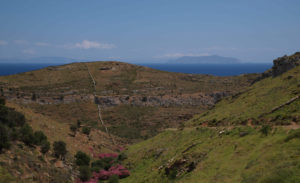–The short ferry ride from Lavrio to Kea is, despite its single hour, quite remarkable. As a student of 20th century Balkan History I had heard of, and read about, the concentration camp island of Makronisos, but I had not realized it lay so close to the mainland. As we slowly sailed past I could see the ruins of buildings and structures…political prisoners, social dissidents and members of the military suspected of being “infected” with dangerous ideas were sent to Makronisos during the Greek Civil War (1946-49). For a more detailed and moving account of this time, read Kevin Andrews’ The Flight of Ikaros: a journey into Greece. Ironically, I re-read this book only a few weeks ago…
–Kea is a rugged place. Smaller than Paros, yet it feels bigger. The Port of Korissia is small and around the port are a number of meadows heading inland, but only for a short distance. After that it is a long climb to the chora, Loulida, perched along the ravine. The streets in the chora are steep and car-free. It is pretty little town and the archeological museum is supposed to be one of the best in Greece. It is, however, only open on Friday from 08:00-15:00 and so I will miss it. Kea reminds me of a smaller and greener Naxos.
–The flora of Kea is very much the same as on Paros and many of the other islands with one lovely exception: the pedunculate oak. For centuries, Kea supplied the tanners of Greece, Rome, Venice, etc… with acorn caps. By the end of the 19th century this practice had been replaced with less expensive synthetic processes so the acorn was not needed and the thriving industry collapsed. Thank God they didn’t cut down the trees! You know what…go here instead. These folks know more about it than I do and are a big part of the new sustainable Kea.
–Kea is still a thriving agricultural island and this is evident when one hikes along the well used donkey paths and other by-ways. Pommes de terre are numerous! The xcero-lithia that crisscross the island are lovely, beautiful, crafted…some are so old that the moss and lichen that cover them are dissolving them, turning their hard edges round and soft. New wall construction is in the old fashion, so the technique is being preserved.
–I will have shot three rolls of 35mm film when I leave on Friday as well as fair amount of digital. I have been hiking a lot although I did rent a car. It is a good idea so at least get up and out of town into the interior before setting out walking to a cove or mountain top. This time of year it is quite empty outside the port, so it has been rare to see anyone else but the occasional goat. Most of the others I have seen are, I think, French and English. I cannot be sure. Athenian day sailors like Kea too.
–If I had brought my mountain bike, I would have rented a car anyway for the same reasons as above. Mountain biking on pavement is a drag and bad for the tires. Best to load the bike into a car and drive inland, park, and bike on the dirt roads. For road biking, anyone who wants constant interval training on hills, come to Kea. The fun never ends.
–JDCM



Comments are closed.